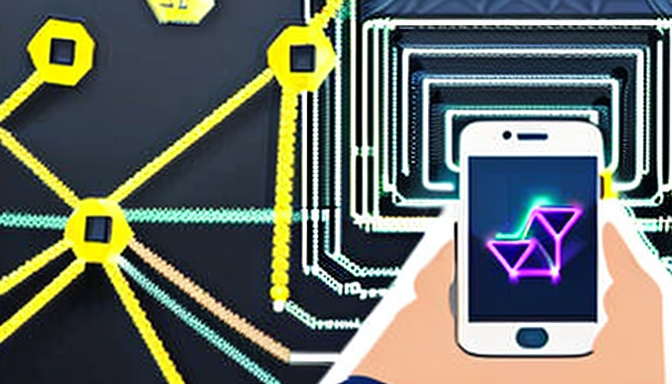Blockchain technology represents a significant advancement in how we manage and secure digital transactions. At its core, it functions as a decentralized digital ledger that records transactions across numerous computers in a manner that is both secure and transparent. Unlike traditional ledgers, which are maintained by a single entity, blockchain allows multiple parties to have access to the same information, fostering trust and accountability.
The fundamentals of blockchain involve a structure made up of individual blocks that contain data. Each block is linked to the previous one, forming a continuous chain. This architecture is supported by a network of nodes—computers that validate and verify transactions. The result is a system that is not only resistant to tampering but also enhances data integrity.
When a transaction occurs, it is first entered into a pool of pending transactions. From here, the data is grouped into a new block. This block is then timestamped and contains a unique cryptographic hash of the previous block, which ensures that all transactions are securely linked. This step-by-step process guarantees that once a block is added to the chain, it cannot be altered without the consensus of the entire network.
One of the key elements of blockchain is the consensus mechanism. This process is essential for establishing trust among participants. Different types of consensus mechanisms, such as Proof of Work and Proof of Stake, are employed to validate transactions. These mechanisms prevent fraud and ensure that the network operates smoothly, even in the absence of a central authority.
Blockchain’s applications extend far beyond cryptocurrency. In healthcare, for instance, it can significantly enhance patient data security and streamline processes. By utilizing blockchain, healthcare providers can securely share patient records, ensuring that data is both accessible and protected against unauthorized access. This can lead to improved patient outcomes and reduced operational costs.
Another area where blockchain shows promise is in supply chain management. By providing a transparent tracking system, blockchain technology can help verify the authenticity of products, reduce fraud, and improve efficiency. For example, companies can trace the origin of goods, ensuring that consumers receive products that are ethically sourced and of high quality.
Despite its advantages, blockchain technology faces several challenges, including scalability and energy consumption. As the number of transactions increases, many blockchain networks struggle to maintain speed and efficiency. Furthermore, the energy-intensive nature of some consensus mechanisms raises environmental concerns, prompting the exploration of more sustainable alternatives.
Looking ahead, the future of blockchain technology is bright, with ongoing research aimed at overcoming current limitations. Emerging trends such as decentralized finance (DeFi) and non-fungible tokens (NFTs) are reshaping the digital landscape, showcasing the adaptability and innovation inherent in blockchain systems.
In conclusion, blockchain technology is a transformative force that has the potential to revolutionize various industries. As it continues to evolve, its implications for sectors like finance, healthcare, and supply chain management will likely expand, leading to more secure and efficient systems.

The Fundamentals of Blockchain Technology
are crucial for understanding its potential and applications in various fields, especially in healthcare and finance. At its core, blockchain is a decentralized digital ledger that records transactions in a secure and transparent manner. This technology consists of three primary components: blocks, a chain connecting these blocks, and a network of nodes that validate transactions.
Each block in a blockchain serves as a container for data. This data often includes transaction details, timestamps, and other relevant information. The design ensures that once a block is filled with data, it is cryptographically linked to the previous block, forming a continuous chain of blocks. This structure not only aids in maintaining the integrity of the data but also enhances security, as altering any single block requires changes to all subsequent blocks, which is nearly impossible without the consensus of the network.
The network of nodes plays a pivotal role in the blockchain ecosystem. These nodes are responsible for validating transactions and ensuring that they comply with the established rules of the network. This validation process typically involves consensus mechanisms, which are methods that help achieve agreement among the nodes on the validity of transactions. Common consensus mechanisms include Proof of Work and Proof of Stake, each with its unique advantages and challenges.
- Proof of Work: This mechanism requires nodes to solve complex mathematical problems to validate transactions, which can be energy-intensive.
- Proof of Stake: In contrast, this method allows validators to create new blocks based on the number of coins they hold, promoting energy efficiency.
Research has shown that blockchain technology can significantly enhance data security and transparency in various applications. For instance, a study published in the Journal of Medical Internet Research highlighted how blockchain can improve the management of patient records, ensuring that data remains tamper-proof while allowing authorized personnel to access it seamlessly.
Moreover, the decentralized nature of blockchain reduces the risk of a single point of failure, making systems more resilient to attacks. This aspect is particularly valuable in sectors like healthcare, where data breaches can have severe consequences. By implementing blockchain, healthcare providers can ensure that patient data is not only secure but also easily verifiable.
In conclusion, understanding the fundamentals of blockchain technology—its structure, components, and mechanisms—is essential for leveraging its potential across various sectors. As the technology continues to evolve, ongoing research and real-world applications will likely unveil further benefits, paving the way for innovative solutions to complex challenges.

How Blockchain Works: A Step-by-Step Process
Blockchain technology operates through a meticulous sequence of steps that ensure the integrity and security of data. This decentralized digital ledger system is fundamentally composed of several key processes: data entry, block creation, validation, and chain integration. Each of these steps plays a crucial role in maintaining the security and immutability of the information recorded within the blockchain.
Initially, when a transaction occurs, it is recorded as data entry. This data is not just a simple record; it includes essential details such as timestamps, transaction amounts, and the parties involved. Once this information is gathered, it is grouped with other transactions to form a block. The process of block creation is critical as it organizes data into a structured format, making it easier to manage and validate.
After a block is created, it enters the validation phase. This is where nodes within the blockchain network come into play. Nodes are individual computers that maintain a copy of the blockchain and participate in the validation process through various consensus mechanisms. These mechanisms, such as Proof of Work or Proof of Stake, ensure that only legitimate transactions are confirmed and added to the blockchain. This step is vital to prevent fraud and maintain trust within the network.
Once a block is validated, it undergoes chain integration. During this step, the new block is attached to the existing blockchain, which already contains a series of previously validated blocks. Each new block contains a cryptographic hash of the previous block, creating an unbreakable link that enhances the security of the entire chain. This design not only ensures that the data remains unchanged but also makes it nearly impossible for malicious actors to alter the information without consensus from the majority of the network.
In summary, the process of how blockchain works is a sophisticated interplay of data entry, block creation, validation, and chain integration. Each step is crucial in ensuring that the information remains secure, transparent, and immutable. As blockchain technology continues to evolve, understanding these fundamental processes will be essential for leveraging its full potential in various applications, from finance to healthcare.
| Step | Description |
|---|---|
| Data Entry | Recording transaction details such as timestamps and amounts. |
| Block Creation | Grouping transactions into a structured block. |
| Validation | Nodes verify transactions through consensus mechanisms. |
| Chain Integration | Adding validated blocks to the blockchain securely. |
Data Entry and Block Creation
in blockchain technology is a critical process that lays the foundation for secure and transparent transactions. When a transaction takes place, it is not processed in isolation; rather, it is aggregated with other transactions into a single unit known as a block. This block serves as a container for multiple transactions and includes essential information such as timestamps, transaction details, and a unique cryptographic hash that links it to the previous block, thereby creating a continuous chain.
Each block contains a specific structure designed to ensure data integrity and security. For instance, the timestamp indicates when the transactions occurred, which is vital for tracking the sequence of events. The transaction data includes details such as the amount, sender, and recipient addresses, providing a comprehensive record of the transaction. This process not only secures the data but also makes it immutable; once a block is added to the blockchain, it cannot be altered without consensus from the network.
To illustrate the importance of data entry and block creation, consider the following example: In a healthcare setting, patient records can be stored as transactions within a blockchain. When a patient receives treatment, the details of that visit—including the date, type of treatment, and healthcare provider—are grouped into a block. This block is then added to the blockchain, creating a permanent, tamper-proof record that can be accessed by authorized personnel. Such a system enhances patient privacy and ensures that medical histories are accurate and up-to-date.
Furthermore, the process of block creation is governed by consensus mechanisms, which are protocols used to validate transactions before they are added to the blockchain. These mechanisms ensure that all nodes in the network agree on the validity of transactions, preventing fraudulent activities and maintaining trust. For example, in a Proof of Work system, miners compete to solve complex mathematical problems to validate transactions and create new blocks, ensuring that only legitimate transactions are recorded.
In summary, the data entry and block creation process in blockchain technology is fundamental to its operation. It not only facilitates secure and transparent transactions but also enhances data integrity and trust within the network. As industries increasingly adopt blockchain for various applications, understanding this process becomes essential for leveraging its full potential.
Transaction Validation by Nodes
Transaction validation is a critical component of blockchain technology, ensuring the integrity and security of transactions within the network. When a transaction is initiated, it is broadcasted to a network of nodes—computers that maintain the blockchain. These nodes play a vital role in the verification process, employing various consensus mechanisms to establish the legitimacy of each transaction before it is permanently recorded on the blockchain.
Consensus mechanisms, such as Proof of Work and Proof of Stake, are designed to prevent fraudulent activities and ensure that all nodes agree on the state of the blockchain. For instance, in the Proof of Work system, nodes (often referred to as miners) compete to solve complex mathematical problems. The first node to solve the problem gets the right to add the new block of transactions to the blockchain. This process not only validates the transactions but also secures the network by making it computationally expensive to alter any part of the blockchain.
Research indicates that the effectiveness of these mechanisms significantly influences the overall security of the blockchain. A study published in the Journal of Cryptography highlights that networks employing robust consensus algorithms experience lower rates of fraud and higher levels of trust among users. This is crucial, particularly in sectors like finance and healthcare, where the authenticity of transactions is paramount.
Furthermore, the decentralized nature of blockchain means that no single entity controls the transaction validation process. This distribution of power among multiple nodes reduces the risk of a single point of failure, making the network more resilient against attacks. For example, in a typical centralized system, a breach in the central server could compromise all transaction data. In contrast, blockchain’s structure ensures that even if one or several nodes are compromised, the remaining nodes can continue to operate and maintain the integrity of the system.
To illustrate the importance of transaction validation, consider a recent case study involving a healthcare provider that implemented blockchain for patient records. By using a blockchain network, the provider ensured that every update to a patient’s record was validated by multiple nodes before being added to the chain. This not only enhanced the security of sensitive health information but also streamlined the process of verifying patient identities and treatment histories.
In conclusion, transaction validation by nodes is essential for maintaining the security and integrity of blockchain technology. As the use of blockchain expands across various industries, understanding the mechanisms behind transaction validation will be crucial for organizations looking to implement this innovative technology.
Chain Integration and Immutability
In the realm of blockchain technology, are pivotal concepts that uphold the integrity and security of data. Once a block is validated through a consensus mechanism, it is permanently affixed to the blockchain, creating a robust framework that prevents unauthorized alterations. This characteristic is crucial in various applications, including finance, healthcare, and supply chain management.
To understand the significance of immutability, consider the traditional data storage systems where records can be modified or deleted, leading to potential fraud or data loss. In contrast, blockchain’s decentralized nature ensures that every transaction is time-stamped and linked to the previous one through a cryptographic hash. This not only secures the data but also provides a transparent audit trail that can be accessed by all participants in the network.
For instance, in the healthcare sector, patient records stored on a blockchain can only be updated by authorized personnel, and any changes are logged as new transactions. This creates a reliable history of a patient’s medical history, which is invaluable for both healthcare providers and patients. A study published in the Journal of Medical Internet Research highlights that blockchain can significantly enhance patient data security and interoperability among systems, ultimately improving healthcare outcomes.
Moreover, the consensus mechanisms employed in blockchain, such as Proof of Work and Proof of Stake, are designed to ensure that all nodes in the network agree on the validity of transactions before they are added to the chain. This collective agreement is essential for maintaining the immutability of the data. If a block were to be altered, it would require the consensus of the majority of the network, making fraudulent activity extremely difficult. As noted in a report by the National Institute of Standards and Technology, this feature of blockchain technology is what sets it apart from conventional databases.
In practical terms, the implications of immutability extend beyond security. For example, in supply chain management, blockchain can track the provenance of goods, ensuring that products are authentic and have not been tampered with. This transparency not only builds consumer trust but also helps companies comply with regulatory requirements.
In conclusion, the integration of blocks into the blockchain, coupled with the immutability of the data, establishes a secure and transparent system that is revolutionizing various industries. As research and technological advancements continue to evolve, the potential applications of blockchain are likely to expand, further demonstrating the importance of these foundational concepts.
Consensus Mechanisms: How Trust is Established
Consensus mechanisms are a cornerstone of blockchain technology, playing a crucial role in establishing trust and security within decentralized networks. These mechanisms ensure that all participating nodes agree on the validity of transactions before they are permanently recorded on the blockchain. This agreement is essential for preventing fraudulent activities and maintaining the integrity of the data across the network.
To illustrate the importance of consensus mechanisms, consider the case of Bitcoin, the first and most well-known cryptocurrency. Bitcoin utilizes a consensus mechanism known as Proof of Work (PoW). In this system, miners compete to solve complex mathematical puzzles, and the first one to solve it gets the right to add a new block to the blockchain. This process not only validates transactions but also secures the network against attacks, as altering any part of the blockchain would require an enormous amount of computational power.
Research has shown that consensus mechanisms can significantly impact the performance and security of blockchain systems. For instance, a study published in the Journal of Cryptology highlighted that different consensus algorithms offer varying levels of security and efficiency. While PoW is highly secure, it is also energy-intensive, leading to environmental concerns. In contrast, Proof of Stake (PoS) is emerging as a more sustainable alternative, allowing validators to create new blocks based on the number of coins they hold and are willing to “stake” as collateral.
The implications of these mechanisms extend beyond cryptocurrencies. In supply chain management, for example, blockchain technology can enhance transparency and traceability. A study by the Institute of Supply Chain Management found that using blockchain with consensus mechanisms can reduce fraud and improve the efficiency of tracking goods. By ensuring that all parties in the supply chain agree on the data, businesses can mitigate risks and enhance trust among stakeholders.
Moreover, consensus mechanisms can also play a vital role in governance and voting systems. By using blockchain technology, organizations can create tamper-proof voting systems where each vote is recorded and verified through consensus. This not only enhances the security of the voting process but also increases public trust in electoral outcomes.
In conclusion, consensus mechanisms are essential for the functionality and reliability of blockchain technology. They provide the necessary framework for validating transactions, securing networks, and fostering trust among participants. As the technology continues to evolve, ongoing research and development will likely yield even more efficient and sustainable consensus models, further expanding the potential applications of blockchain across various sectors.

Applications of Blockchain Technology
Blockchain technology has evolved beyond its initial association with cryptocurrencies, demonstrating its broad applicability across numerous sectors. By providing a secure, transparent, and decentralized method for recording transactions, blockchain offers innovative solutions to longstanding challenges in various industries.
One prominent application of blockchain technology is in healthcare. The healthcare sector faces significant issues regarding data security, patient privacy, and interoperability among different systems. By utilizing blockchain, patient records can be securely stored and shared among authorized providers without the risk of data breaches. A study published in the Journal of Medical Internet Research highlighted that blockchain could enhance patient consent management, ensuring that individuals have control over who accesses their data and under what circumstances. Furthermore, blockchain can streamline the drug supply chain, reducing the risk of counterfeit medications by providing a transparent tracking system from manufacturer to consumer.
In the realm of supply chain management, blockchain technology is transforming how goods are tracked and verified. Traditional supply chains often suffer from inefficiencies and lack of transparency, leading to issues such as fraud and delays. By implementing blockchain, companies can achieve real-time tracking of products, ensuring authenticity and reducing the risk of fraud. According to a report by the World Economic Forum, blockchain could reduce supply chain costs by up to 20% by enhancing transparency and reducing the need for intermediaries.
Another critical application is in voting systems. The integrity of elections is paramount, and blockchain technology can provide a secure and transparent voting process. By allowing votes to be recorded on a blockchain, the risk of tampering and fraud can be significantly minimized. A pilot project in Utah County, USA, demonstrated that blockchain-based voting could enhance voter confidence and participation by ensuring that each vote is accurately counted and verifiable.
Moreover, blockchain technology is making strides in the field of finance, particularly through the development of decentralized finance (DeFi) platforms. These platforms utilize smart contracts on blockchains to facilitate financial transactions without the need for traditional banks, offering users greater control over their financial assets. A report from CoinDesk indicated that the DeFi market has grown exponentially, showcasing the potential for blockchain to disrupt traditional financial systems.
In conclusion, the versatility of blockchain technology extends far beyond cryptocurrency. Its applications in healthcare, supply chain management, and voting systems illustrate its potential to solve complex problems across various sectors. As research continues to evolve, the integration of blockchain into these industries promises enhanced security, transparency, and efficiency.
Blockchain in Healthcare
Blockchain technology has emerged as a transformative force in the healthcare sector, offering innovative solutions to longstanding challenges related to data security, process efficiency, and system interoperability. By leveraging its decentralized nature, blockchain can significantly enhance the way patient information is stored, shared, and utilized across various healthcare systems.
One of the most compelling advantages of blockchain in healthcare is its ability to enhance patient data security. Traditional databases are vulnerable to cyberattacks, leading to potential breaches of sensitive patient information. In contrast, blockchain employs advanced cryptographic techniques that ensure data is not only secure but also immutable. For instance, a study published in the Journal of Medical Internet Research highlighted a blockchain-based system that successfully protected patient records from unauthorized access, demonstrating a marked decrease in data breaches compared to conventional methods.
Furthermore, blockchain can streamline processes within healthcare organizations. By automating administrative tasks such as patient registration and billing through smart contracts, healthcare providers can reduce the time and resources spent on these activities. A pilot program conducted by a leading hospital network showed that implementing blockchain for billing processes resulted in a 30% reduction in administrative costs and a significant decrease in billing errors.
Interoperability is another critical area where blockchain shines. Healthcare systems often operate in silos, leading to fragmented patient data that can hinder effective treatment. Blockchain facilitates seamless data exchange between different healthcare entities, ensuring that all stakeholders have access to a complete and accurate patient history. According to research from the American Journal of Managed Care, the integration of blockchain technology led to improved care coordination and a 20% increase in patient satisfaction scores.
However, the implementation of blockchain in healthcare is not without its challenges. Issues such as scalability, regulatory compliance, and the need for standardization must be addressed to fully realize its potential. For example, a survey conducted by the Healthcare Information and Management Systems Society found that while 74% of healthcare executives believe blockchain will be widely adopted, only 22% have a clear strategy for its implementation.
In conclusion, the integration of blockchain technology in healthcare presents a promising avenue for enhancing patient data security, streamlining operational processes, and improving interoperability among systems. As research continues to validate its benefits, stakeholders must collaborate to overcome existing challenges, paving the way for a more efficient and secure healthcare landscape.
Blockchain in Supply Chain Management
Blockchain technology is revolutionizing supply chain management by providing an unprecedented level of transparency and traceability. This innovation enables organizations to track goods from their origin to the end consumer, significantly reducing the risk of fraud and enhancing operational efficiency. With the ability to verify the authenticity of products, blockchain is paving the way for a more reliable supply chain ecosystem.
One of the most significant benefits of using blockchain in supply chains is its capacity to combat fraud. Traditional supply chain systems often rely on paper-based documentation, which can be easily manipulated. In contrast, blockchain records transactions in a decentralized ledger that is immutable and transparent. For example, a study conducted by the World Economic Forum found that implementing blockchain could reduce the cost of fraud in supply chains by up to 30%. This reduction is achieved through real-time tracking and verification of goods, ensuring that every transaction is recorded and accessible to all parties involved.
Additionally, blockchain enhances operational efficiency by streamlining processes. For instance, companies can automate various supply chain activities through smart contracts—self-executing contracts with the terms directly written into code. These contracts can automatically trigger payments and shipments once predefined conditions are met, thereby reducing delays and the need for intermediaries. Research from Accenture indicates that using smart contracts can lead to a 20% decrease in administrative costs.
Moreover, the ability to ensure product authenticity is crucial in industries such as pharmaceuticals and food production. By utilizing blockchain, companies can provide consumers with detailed histories of their products, including sourcing, handling, and shipping information. This level of transparency not only builds consumer trust but also helps in complying with regulatory standards. A case study involving a major food retailer demonstrated that implementing blockchain technology resulted in a 40% reduction in the time needed to trace the origin of food products during safety recalls.
In conclusion, the integration of blockchain technology in supply chain management is not just a trend; it is a transformative approach that enhances transparency, reduces fraud, and ensures product authenticity. As industries continue to adopt this technology, the long-term benefits will likely become even more pronounced, leading to a more efficient and trustworthy supply chain landscape.
- Key Benefits of Blockchain in Supply Chain:
- Fraud reduction
- Increased operational efficiency
- Enhanced product authenticity
| Study/Source | Findings |
|---|---|
| World Economic Forum | 30% reduction in fraud costs |
| Accenture | 20% decrease in administrative costs |
| Food Retailer Case Study | 40% reduction in traceability time |

Challenges and Limitations of Blockchain
Blockchain technology has garnered significant attention for its potential to revolutionize various sectors. However, despite its numerous advantages, it faces a series of challenges and limitations that must be addressed to facilitate widespread adoption.
One of the most pressing issues is scalability. As the number of transactions increases, many blockchain networks experience slow processing times. For instance, Bitcoin can only handle about 3 to 7 transactions per second, compared to Visa, which processes over 24,000 transactions per second. This disparity poses a significant barrier for applications requiring high transaction throughput, such as financial services and e-commerce. Researchers are exploring various solutions, including sharding and layer-2 scaling solutions like the Lightning Network, to enhance scalability without compromising security.
Another critical concern is energy consumption. Many blockchain networks, particularly those utilizing the Proof of Work consensus mechanism, have been criticized for their substantial energy requirements. A study by the University of Cambridge found that Bitcoin mining consumes more energy annually than some countries. This raises environmental concerns and prompts the need for more sustainable alternatives, such as Proof of Stake and other eco-friendly consensus mechanisms that require significantly less energy.
Additionally, regulatory uncertainty poses a challenge for blockchain’s growth. Governments worldwide are still grappling with how to regulate this rapidly evolving technology. The lack of clear regulations can hinder innovation and deter investment. For instance, in the European Union, the proposed Markets in Crypto-Assets (MiCA) regulation aims to provide a comprehensive legal framework for cryptocurrencies and blockchain technology. However, the implementation of such regulations will take time and may face opposition from various stakeholders.
In summary, while blockchain technology presents transformative opportunities across numerous fields, it is essential to address its challenges—scalability, energy consumption, and regulatory uncertainty. Only by overcoming these obstacles can blockchain realize its full potential and achieve widespread adoption.
- Scalability: Solutions like sharding and layer-2 networks are being explored.
- Energy Consumption: Transitioning to eco-friendly consensus mechanisms is crucial.
- Regulatory Uncertainty: Clear regulations are needed to foster innovation and investment.
Scalability Issues
in blockchain technology have emerged as a critical challenge, particularly as transaction volumes continue to surge across various networks. The need for rapid processing and efficiency is paramount, especially in sectors such as finance, healthcare, and logistics. When transaction loads increase, many blockchain systems face significant hurdles in maintaining their operational speed and overall effectiveness.
One of the primary reasons for these scalability issues lies in the architecture of traditional blockchain networks. For instance, in networks utilizing the Proof of Work consensus mechanism, each transaction requires substantial computational power and time to validate. This process not only slows down transaction speeds but also increases energy consumption, raising concerns about sustainability. Research indicates that Bitcoin, for example, can handle only about 3 to 7 transactions per second, a stark contrast to centralized systems like Visa, which can process thousands of transactions in the same timeframe.
To address these challenges, innovative solutions are being developed. Layer 2 solutions, such as the Lightning Network for Bitcoin, aim to facilitate faster transactions by creating off-chain channels that settle back to the main blockchain. This approach significantly enhances transaction throughput without compromising the security of the underlying network. According to a study by the MIT Digital Currency Initiative, such solutions have the potential to increase Bitcoin’s transaction capacity to millions per second.
Another approach involves the adoption of sharding, a method that divides the blockchain into smaller, more manageable pieces called shards. Each shard processes its transactions independently, allowing for parallel processing and reducing the load on the main chain. Research by Ethereum’s development team has shown that sharding could enable the network to handle thousands of transactions per second, thus enhancing scalability significantly.
Furthermore, the integration of proof-of-stake mechanisms offers a promising alternative to traditional consensus methods. Unlike proof of work, proof of stake requires validators to hold a stake in the network, which can lead to faster transaction processing times and lower energy consumption. A study published in the Journal of Blockchain Research highlighted that networks employing proof of stake can achieve improved scalability while maintaining robust security protocols.
In conclusion, while scalability remains a pressing issue for blockchain technology, ongoing research and innovative solutions hold the promise of enhancing transaction speeds without sacrificing security. As the landscape of blockchain continues to evolve, the adoption of these advanced methodologies will be crucial in facilitating broader implementation across various industries.
Energy Consumption Concerns
The energy consumption of blockchain technology, particularly through consensus mechanisms like Proof of Work (PoW), has become a significant topic of discussion among environmentalists, researchers, and technology developers. PoW requires substantial computational power to solve complex mathematical problems, which in turn leads to high electricity usage. This energy-intensive process raises environmental concerns, prompting an urgent need for exploring more sustainable alternatives.
According to a study published in the journal Nature Communications, the energy consumption of Bitcoin mining alone is comparable to that of entire countries. The authors highlighted that the environmental impact of PoW extends beyond mere energy use; it also contributes to carbon emissions if the electricity consumed is sourced from fossil fuels. This has led to increased scrutiny from regulatory bodies and the public alike.
In response to these challenges, researchers and developers are investigating alternative consensus mechanisms. One prominent example is Proof of Stake (PoS), which drastically reduces energy consumption. Unlike PoW, PoS does not require extensive computational resources; instead, it selects validators based on the number of coins they hold and are willing to “stake” as collateral. This method has been shown to reduce energy usage by up to 99% compared to PoW, as demonstrated in the Ethereum network’s transition from PoW to PoS.
Moreover, other innovative approaches like Delegated Proof of Stake (DPoS) and Proof of Authority (PoA) are gaining traction. DPoS allows stakeholders to elect a small number of delegates to validate transactions, further enhancing efficiency and reducing energy expenditure. PoA, on the other hand, relies on a limited number of approved validators, significantly cutting down the computational work required.
As blockchain technology continues to evolve, its environmental impact remains a pivotal concern. A report by the International Energy Agency (IEA) suggests that transitioning to renewable energy sources for mining operations could mitigate the carbon footprint associated with PoW. For instance, using solar or wind energy can make mining operations more sustainable, aligning with global efforts to combat climate change.
In conclusion, while the energy consumption of traditional consensus mechanisms like PoW poses significant environmental challenges, ongoing research and development of alternative methods offer promising solutions. By adopting more sustainable practices and technologies, the blockchain industry can reduce its ecological impact while maintaining the integrity and functionality that have made it a revolutionary force in the digital landscape.

The Future of Blockchain Technology
The future of blockchain technology is poised to transform numerous sectors, driven by ongoing research and development efforts to address existing limitations. As the landscape evolves, blockchain is increasingly recognized for its potential to enhance security, transparency, and efficiency across various applications.
One significant area of focus is the improvement of scalability. Current blockchain networks often face challenges when handling a high volume of transactions, which can lead to delays and increased costs. For instance, Ethereum, one of the most widely used blockchain platforms, has been working on transitioning to a Proof of Stake consensus mechanism to enhance its scalability and energy efficiency. This shift aims to accommodate a greater number of transactions per second, thereby supporting a broader range of applications.
Moreover, the integration of interoperability between different blockchain networks is gaining traction. Projects like Polkadot and Cosmos are pioneering frameworks that allow disparate blockchains to communicate and share data seamlessly. This development is crucial for creating a cohesive ecosystem where various blockchain applications can function together, enhancing overall utility and user experience.
In addition to scalability and interoperability, the adoption of sustainable practices is becoming increasingly important. The environmental impact of blockchain, particularly those using energy-intensive consensus mechanisms like Proof of Work, has prompted researchers to explore alternatives. Initiatives focusing on energy-efficient consensus models, such as Proof of Authority and Delegated Proof of Stake, are being developed to mitigate these concerns, making blockchain a more viable option for environmentally conscious organizations.
Furthermore, the rise of decentralized finance (DeFi) and non-fungible tokens (NFTs) exemplifies the innovative applications of blockchain technology. DeFi platforms are revolutionizing traditional financial services by providing decentralized alternatives to lending, borrowing, and trading, thereby democratizing access to financial resources. Meanwhile, NFTs are reshaping the art and entertainment industries by enabling unique digital ownership and provenance tracking.
As regulatory frameworks begin to take shape globally, the impact of regulation on blockchain development cannot be understated. Governments are increasingly recognizing the need to create guidelines that foster innovation while protecting consumers and ensuring security. The establishment of clear regulations will not only enhance trust among users but also encourage investment in blockchain technologies.
In conclusion, the future of blockchain technology is bright, characterized by ongoing advancements aimed at overcoming existing challenges. With a focus on scalability, interoperability, sustainability, and regulatory clarity, blockchain is set to expand its applications across various sectors, ultimately transforming how we conduct transactions and manage data.
Emerging Trends in Blockchain
Emerging trends in blockchain technology are revolutionizing various sectors, particularly in finance and digital assets. Two of the most significant trends are the rise of decentralized finance (DeFi) and non-fungible tokens (NFTs). These innovations are not only reshaping the digital landscape but also demonstrating the adaptability and versatility of blockchain technology.
Decentralized finance refers to a broad category of financial applications in cryptocurrency or blockchain geared toward disrupting financial intermediaries. Traditional finance relies on banks and other financial institutions to facilitate transactions, manage assets, and provide liquidity. In contrast, DeFi platforms utilize smart contracts on blockchains, primarily Ethereum, to perform these functions without intermediaries. This shift enables users to lend, borrow, and trade assets directly, often with lower fees and increased accessibility.
A study by the World Economic Forum highlights that DeFi could potentially replace traditional financial systems, offering higher transparency and efficiency. For instance, platforms like Compound and Aave allow users to earn interest on their cryptocurrency holdings or take out loans without the need for credit checks. This democratization of finance is particularly beneficial for individuals in underbanked regions, providing them with access to financial services that were previously unavailable.
On the other hand, non-fungible tokens (NFTs) represent a unique digital asset verified using blockchain technology, making them distinct from cryptocurrencies. NFTs have gained immense popularity, particularly in the art and entertainment industries, where they allow creators to tokenize their work. This tokenization not only provides artists with new revenue streams but also enables collectors to own verifiable digital assets.
Research from NonFungible.com indicates that the NFT market has seen exponential growth, with sales surpassing $10 billion in 2021 alone. This trend is exemplified by high-profile sales, such as Beeple’s digital artwork selling for $69 million at Christie’s auction house. Such events highlight the potential of NFTs to transform the way we perceive ownership and value in the digital realm.
Despite the promising developments in DeFi and NFTs, there are challenges that must be addressed. Issues such as regulatory uncertainty, security vulnerabilities, and market volatility pose risks to users and investors alike. As the blockchain landscape continues to evolve, stakeholders must collaborate to create robust frameworks that ensure security and promote responsible innovation.
In conclusion, the rise of decentralized finance and non-fungible tokens signifies a pivotal moment in the evolution of blockchain technology. As these trends continue to gain traction, they will likely influence various sectors, paving the way for a more inclusive and innovative digital economy.
Regulatory Developments and Their Impact
Regulatory developments surrounding blockchain technology are rapidly evolving as governments and regulatory bodies worldwide recognize the transformative potential of this innovative system. These regulations are crucial in shaping how blockchain is integrated into various sectors, particularly in finance and healthcare, where data integrity and security are paramount.
As blockchain technology gains traction, regulatory frameworks are emerging to address the unique challenges it presents. For instance, the European Union’s MiCA (Markets in Crypto-Assets) proposal aims to create a comprehensive regulatory framework for digital assets, ensuring consumer protection while fostering innovation. This initiative is pivotal in establishing trust in blockchain applications, particularly in financial transactions.
In the healthcare sector, regulations are being developed to govern the use of blockchain for patient data management. The Health Insurance Portability and Accountability Act (HIPAA) in the United States is one such regulation that mandates strict guidelines for patient data privacy. As blockchain technology offers enhanced security and transparency, aligning it with HIPAA requirements can revolutionize how healthcare providers manage sensitive information.
Furthermore, the integration of blockchain into existing systems poses regulatory challenges that require careful consideration. For example, the use of blockchain for electronic health records (EHR) must comply with existing data protection laws. A study published in the Journal of Medical Internet Research highlights the importance of developing regulatory standards that accommodate the decentralized nature of blockchain while ensuring compliance with established data protection regulations.
Moreover, the potential for smart contracts to automate processes within various industries necessitates a regulatory framework that addresses their legal standing. As highlighted by a report from the World Economic Forum, clear guidelines on the enforceability of smart contracts will be essential for businesses looking to leverage blockchain technology effectively.
In addition to enhancing security and efficiency, regulations can also stimulate innovation. By providing a clear legal framework, companies are more likely to invest in blockchain solutions, knowing they operate within a defined regulatory environment. This has been observed in countries like Singapore, where proactive regulatory measures have positioned the nation as a leading hub for blockchain innovation.
In conclusion, as governments worldwide establish regulations for blockchain technology, the impact on its development and integration into existing systems will be profound. These regulations are not only essential for ensuring compliance and security but also for fostering innovation and building trust in this transformative technology. As the landscape continues to evolve, ongoing dialogue between regulators, industry stakeholders, and the public will be crucial in shaping a balanced approach that maximizes the benefits of blockchain while addressing its challenges.
Frequently Asked Questions
- What is blockchain technology?
Blockchain technology is a decentralized digital ledger that securely records transactions across multiple computers. It ensures transparency and security, making it a game-changer for various industries, especially finance and healthcare.
- How does blockchain work?
Blockchain operates through a series of steps: data entry, block creation, validation, and chain integration. Each block contains a cryptographic hash of the previous block, ensuring that once data is recorded, it cannot be altered without consensus from the network.
- What are consensus mechanisms?
Consensus mechanisms are essential to the functionality of blockchain. They ensure that all nodes in the network agree on the validity of transactions, preventing fraud and maintaining trust within the system.
- What are the applications of blockchain?
Blockchain’s applications extend beyond cryptocurrency. It is used in supply chain management, healthcare, voting systems, and more, showcasing its versatility and potential to improve various processes.
- What challenges does blockchain face?
Despite its advantages, blockchain technology faces challenges such as scalability issues, high energy consumption, and regulatory uncertainties. These challenges need to be addressed for broader adoption and effectiveness.
- What is the future of blockchain technology?
The future of blockchain looks promising, with ongoing research aimed at overcoming current limitations. Emerging trends like decentralized finance (DeFi) and non-fungible tokens (NFTs) are already reshaping the digital landscape.














